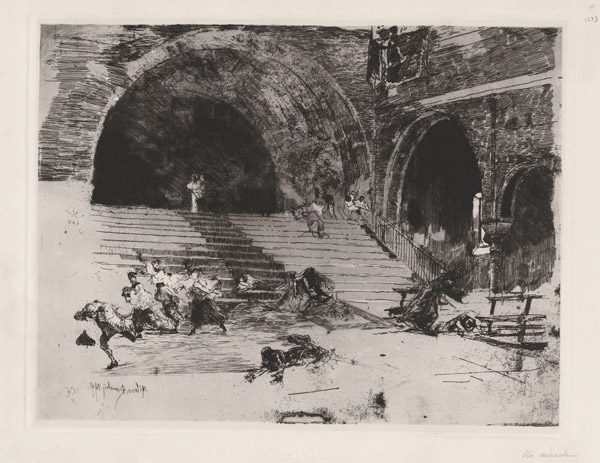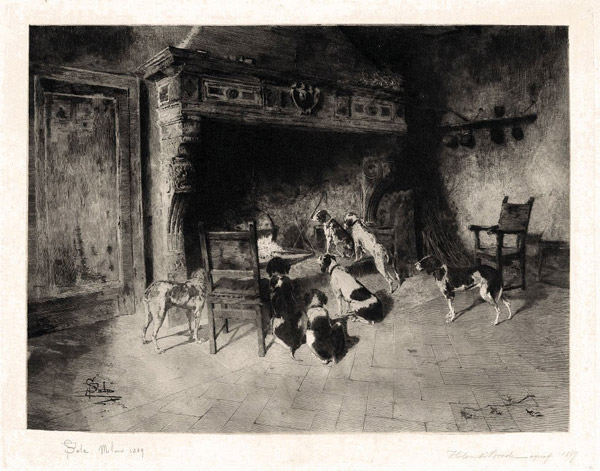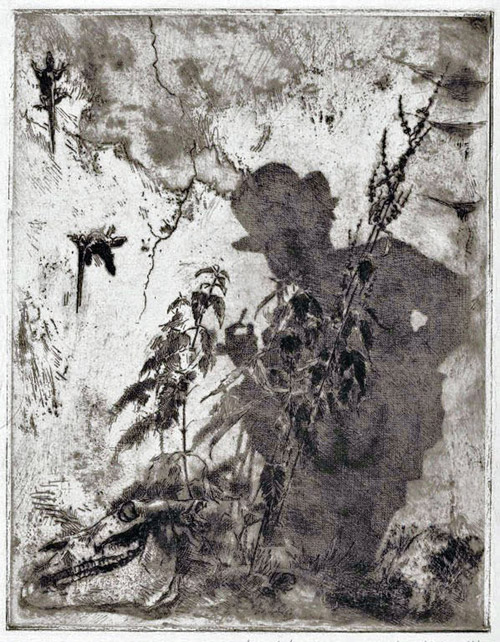Milan

Giberto Borromeo
Milan, 1815–1885
Forest on Lago Maggiore (Foresta sul Lago Maggiore), 1870
etching, proof before letters
The Ahmanson Foundation, 2013.31.5

Mosè Bianchi
Monza (Milan), 1840–1904
A Miracle (Un miracle), 1874
etching with aquatint on chine collé
Purchased as the Gift of Matthew and Ann Nimetz, 2014.63.1

Francesco Colombi Borde
Cremona, 1846–1905
Hunting Dogs (Cani di caccia), after Paolo Sala, 1889
etching, proof before letters
Pepita Milmore Memorial Fund, 2013.30.10
The revival of pure, artistic etching was not limited to the original works of painters like Fontanesi, Fortuny, and Bianchi. From the same time, starting in the 1860s, reproductive printmakers turned to the technique, with its potential for more convincing naturalism and vigorous personal expression, for their interpretations of new kinds of painting that ranged from scenes of recent history to subjects from literature and daily life (such as the contemporary painter Sala’s popular depictions of animals). Colombi Borde, along with Turletti and Pagliano, were masters of this of type of print.

Eleuterio Pagliano
Casale Monferrato (Alessandria), 1826–Milan, 1903
Indian Summer (L’Estate di San Martino), c. 1883
etching on chine collé
The Ahmanson Foundation, 2013.31.9

Luigi Conconi
Milan, 1852–1917
The Contemplative Life (Vita contemplativa), c. 1883
etching
Purchased as the Gift of Matthew and Ann Nimetz, 2013.115.4
Conconi was a leader of the Scapigliatura, a principally Milanese movement of “disheveled” or “unkempt” artists who rejected middle-class values and embraced a bohemian lifestyle. The subject here was identified by the artist as a self-portrait, though his appearance is limited to a shadow cast upon a dirty and crumbling wall. This, the vegetation, and—most explicitly—the horse’s skull at lower left are reminders of the transience of material things, and of life itself. The title reinforces that meaning. In the context of the Scapigliatura, this theme exhorted viewers to live every day as if it were their last.

Luigi Conconi
Milan, 1852–1917
Intoxication (Ebbrezza), 1888
etching with monotype inking
Pepita Milmore Memorial Fund, 2013.30.11
Intoxication exemplifies the embrace of the bohemian life and uninhibited self-expression of the Scapigliatura movement: dragging on a cigarette, a woman reclines provocatively amid empty wine glasses on a bunched-up tablecloth. The print is a fine example of how Conconi would establish a composition with a mere framework of etched lines on the plate and then develop the appearance and expressive character of each impression through inking alone. This “monotype inking” was characteristic of printmaking in Milan in the late nineteenth century.

Vittore Grubicy
Milan, 1851–1920
Antwerp: Sunset (Anversa: Tramonto), 1893/1894
aquatint and softground etching with monotype inking, proof touched with graphite and blue pencil on chine collé
Pepita Milmore Memorial Fund, 2013.30.19

Mosè Bianchi
Monza (Milan), 1840–1904
Woods in the Park near Monza, 1895
etching, softground etching, and aquatint
Purchased as the Gift of Matthew and Ann Nimetz, 2013.115.2
The most avant-garde painter in Milan, and the closest in spirit to the French impressionists, Bianchi was also the city’s first artist to explore the full technical and expressive potential of etching. Although the primary focus of his prints was urban life, he turned to landscape in the 1890s. Bianchi also treated religious subjects with originality and devout feeling, as in A Miracle, which alludes to the Resurrection of Christ.

Pompeo Mariani
Monza (Milan), 1857–Bordighera (Imperia), 1927
Reading in a Garden (Lettura in giardino), 1904/1905
color monotype with scraping, additional oil color, graphite, and colored pencils
Pepita Milmore Memorial Fund, 2013.31.15
This is an especially beautiful example of Mariani’s work. Taking the Milanese taste for distinctive impressions to its logical conclusion, he made some hundred monotypes, inking or painting the design directly onto a smooth surface and printing a single image. This print of a young woman of society, in seemingly perfect harmony with the surrounding landscape, combines Mariani’s preferred subjects as a painter, while its evanescent color and soft atmosphere evoke the beauty of the Lombard countryside.

Enrico Vegetti
Turin, 1863–Nernier (France), 1951
Pescarenico Seen across the River Adda, 1920s
etching with monotype wiping
Ailsa Mellon Bruce Fund, 2013.117.3